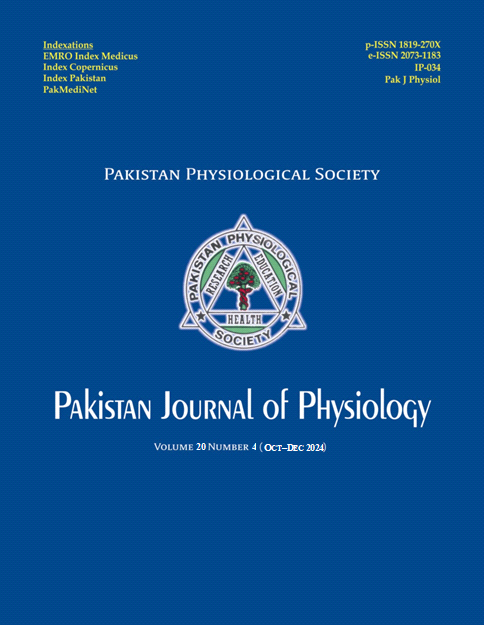INTRAOPERATIVE AND POSTOPERATIVE COMPLICATION OF CATARACT SURGERY IN DIABETES
DOI:
https://doi.org/10.69656/pjp.v20i4.1716Keywords:
Diabetes, phacoemulsification, cataractAbstract
Background: The incidence of diabetes worldwide is rising; cataract is a common ocular pathology and phacoemulsification with IOL implantation the preferred treatment. Objective of this study was to assess the visual acuity and rate of intraoperative and postoperative complications in eyes of diabetic and non-diabetic patients undergoing cataract surgery by phacoemulsification. Methods: In this quasi experimental study 200 eyes of 200 patients (100 diabetic, 100 non-diabetic) underwent phacoemulsification surgery. Best corrected visual acuity (BCVA), intraoperative, postoperative complications were measured and compared in both groups before and after surgery up to 4 months. Results: In 200 samples the ages were 56.6±6.3 years, 54% were male, 50% were diabetic. Among non-diabetics 76% had BCVA 6/6–6/12 postop, 24% had BCVA of 6/18 or >6/18 postop, 4% had uveitis, 42% had mild keratopathy, 8% had severe keratopathy and 10% had had (posterior capsular opacity) PCO. In diabetics 52% had BCVA 6/6–6/12 postop, 50% had BCVA of 6/18 or >6/18 postop, 28% had uveitis, 26% had mild keratopathy, 24% had severe keratopathy, 18% had worsening of retinopathy, and 30% PCO (p<0.05). Two percent non-diabetics had iris trauma; 4% diabetics had posterior capsular rupture (PCR), 2% had dropped nucleus and 6% had iris trauma. Intraoperative parameters were statistically insignificant (p>0.05). Conclusion: In cataract surgeries with phacoemulsification postoperative complication rate were found significantly higher in diabetics with non-diabetics achieving a better postoperative visual acuity. No significant differences in intraoperative complication rate were found among the cases.Pak J Physiol 2024;20(4):21?3, DOI: https://doi.org/10.69656/pjp.v20i4.1716
Downloads
References
Wild S, Roglic G, Green A, Sicree R, King H. Global prevalence of diabetes: estimates for the year 2000 and projections for 2030. Diabetes Care 2004;27(5):1047–53.
International Diabetes Federation (IDF). Diabetes Atlas, 9th ed. Brussels, Belgium: International Diabetes Federation; 2019.
Wong TY, Cheung CM, Larsen M, Sharma S, Simó R. Diabetic retinopathy. Nat Rev Dis Primers 2016;2:16012.
Wang W, Lo ACY. Diabetic Retinopathy: Pathophysiology and treatments. Int J Mol Sci 2018;19(6):1816.
Simó R, Hernández C; European Consortium for the Early Treatment of Diabetic Retinopathy (EUROCONDOR). Neurodegeneration in the diabetic eye: new insights and therapeutic perspectives. Trends Endocrinol Metab 2014;25(1):23–33.
Carpi-Santos R, de Melo Reis RA, Gomes FCA, Calaza KC. Contribution of Müller cells in the diabetic retinopathy development: Focus on oxidative stress and inflammation. Antioxidants (Basel) 2022;11(4):617.
Lai D, Wu Y, Shao C, Qiu Q. The role of Müller cells in diabetic macular edema. Invest Ophthalmol Vis Sci 2023;64(10):8.
Ba-Ali S, Larsen M, Andersen HU, Lund-Andersen H. Full-field and multifocal electroretinogram in non-diabetic controls and diabetics with and without retinopathy. Acta Ophthalmol 2022;100(8):e1719–28.
Di Leo MA, Caputo S, Falsini B, Porciatti V, Greco AV, Ghirlanda G. Presence and further development of retinal dysfunction after 3-year follow up in IDDM patients without angiographically documented vasculopathy. Diabetologia 1994;37(9):911–6.
Harding JJ, Egerton M, van Heyningen R, Harding RS. Diabetes, glaucoma, sex, and cataract: analysis of combined data from two case control studies. Br J Ophthalmol 1993;77(1):2–6.
Mrugacz M, Pony-Uram M, Bryl A, Zorena K. Current approach to the pathogenesis of diabetic cataracts. Int J Mol Sci 2023;24(7):6317.
Kelkar A, Kelkar J, Mehta H, Amoaku W. Cataract surgery in diabetes mellitus: A systematic review. Indian J Ophthalmol 2018;66(10):1401–10.
Chew EY, Benson WE, Remaley NA, Lindley AA, Burton TC, Csaky K, et al. Results after lens extraction in patients with diabetic retinopathy: early treatment diabetic retinopathy study report number 25. Arch Ophthalmol 1999;117(12):1600–6.
Saad Filho R, Moreto R, Nakaghi RO, Haddad W, Coelho RP, Messias A. Costs and outcomes of phacoemulsification for cataracts performed by residents. Arq Bras Oftalmol 2020;83(3):209–14.
Kato S, Oshika T, Numaga J, Hayashi Y, Oshiro M, Yuguchi T, Kaiya T. Anterior capsular contraction after cataract surgery in eyes of diabetic patients. Br J Ophthalmol 2001;85(1):21–3.
Takamura Y, Tomomatsu T, Yokota S, Matsumura T, Takihara Y, Inatani M. Large capsulorhexis with implantation of a 7.0 mm optic intraocular lens during cataract surgery in patients with diabetes mellitus. J Cataract Refract Surg 2014;40(11):1850–6.
Saxena S, Mitchell P, Rochtchina E. Five-year incidence of cataract in older persons with diabetes and pre-diabetes. Ophthalmic Epidemiol 2004;11(4):271–7.
Go JA, Mamalis CA, Khandelwal SS. Cataract surgery considerations for diabetic patients. Curr Diab Rep 2021;21(12):67.
Cahill M, Eustace P, de Jesus V. Pupillary autonomic denervation with increasing duration of diabetes mellitus. Br J Ophthalmol 2001;85(10):1225–30.
Cetinkaya A, Yilmaz G, Akova YA. Photic retinopathy after cataract surgery in diabetic patients. Retina 2006;26(9):1021–8.
Shih KC, Lam KS, Tong L. A systematic review on the impact of diabetes mellitus on the ocular surface. Nutr Diabetes 2017;7(3):e251.
Yang R, Sha X, Zeng M, Tan Y, Zheng Y, Fan F. The influence of phacoemulsification on corneal endothelial cells at varying blood glucose levels. Eye Sci 2011;26(2):91–5.
Ivanci? D, Mandi? Z, Bara? J, Kopi? M. Cataract surgery and postoperative complications in diabetic patients. Coll Antropol 2005;29(Suppl 1):55–8.
Chancellor J, Soliman MK, Shoults CC, Faramawi MF, Al-Hindi H, Kirkland K, et al. Intraoperative complications and visual outcomes of cataract surgery in diabetes mellitus: a multicenter database study. Am J Ophthalmol 2021;225:47–56.
Downloads
Published
How to Cite
Issue
Section
License

This work is licensed under a Creative Commons Attribution-NoDerivatives 4.0 International License.
The author(s) retain the copyrights and allow their publication in Pakistan Journal of Physiology, Pak J Physiol, PJP to be FREE for research and academic purposes. It can be downloaded and stored, printed, presented, projected, cited and quoted with full reference of, and acknowledgement to the author(s) and the PJP. The contents are published with an international CC-BY-ND-4.0 License.












